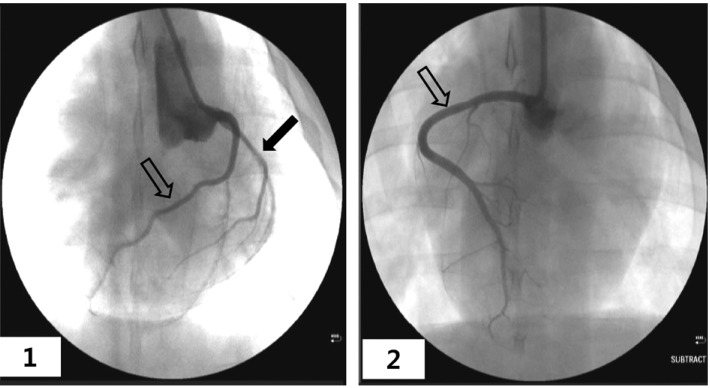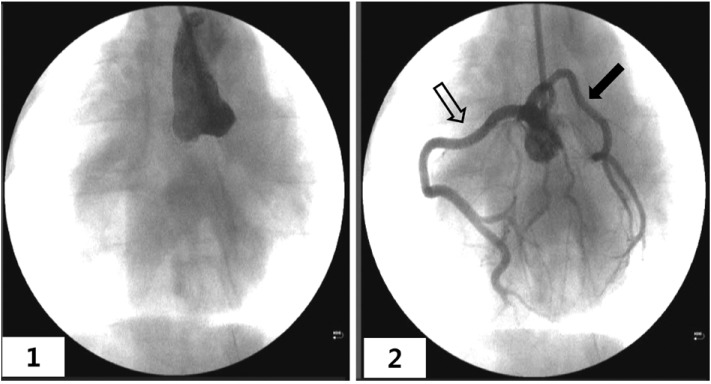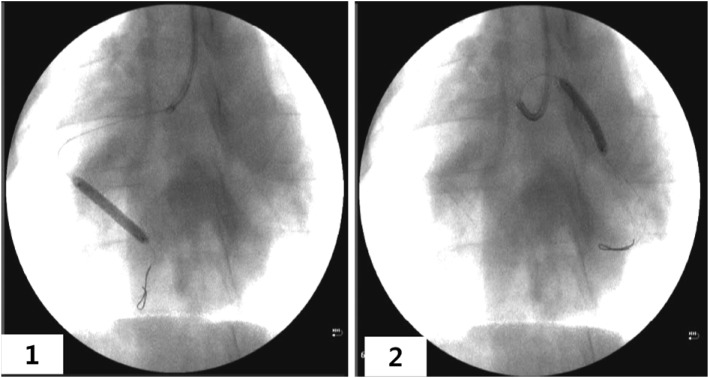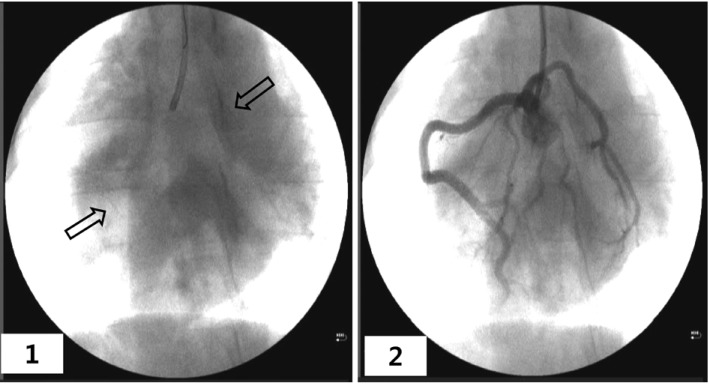Abstract
Single coronary artery is a rare coronary artery anomaly. Very few previous reports of this anatomical malformation in swine have been found. A 22 kg Yorkshire X Landrace F1 crossbred castrated male swine was presented for enrollment in a coronary stent implantion study. Coronary angiography revealed a single coronary artery arising from the right aortic sinus. The right coronary artery and anomalous left coronary artery were implanted with novel coronary stents without any side effects.
Because the porcine cardiac and coronary artery anatomy is similar to that in humans, swine are important laboratory large animal models in cardiovascular research [3,8-9,12]. The normal left coronary artery of humans and swine divides into a left anterior descending artery (LAD) and left circumflex artery (LCX) (Figure 1-1). The normal right coronary artery (RCA) arises from the right aortic sinus and travels between the right auricle and pulmonary trunk (Figure 1-2).
The incidence of coronary artery anomalies is approximately 1-2% in human beings [2]. In a coronary angiographic analysis of 16,573 patients, coronary malformations were detected in 48 (0.29%). The origin of the LCX from the RCA or right aortic sinus was the most common anomaly (28 patients [58.3%]). An anomalous RCA originating from the LAD or LCX was observed in six patients (12.5%). The left coronary artery originated from the right aortic sinus in five patients, and the LAD originated from the RCA or the right aortic sinus in five patients. The RCA originated from the left aortic sinus in three patients and from an ectopic ostium in the ascending aorta in one patient [11]. In 126,595 American people, the coronary artery malformation rate was 1.3 % and various coronary artery anomalies have been reported [1,10]. There have been many reports of coronary anomalies in human interventional cardiology cases [4-6,10], but previous reports of anomalies in swine are very rare [7]. We conducted an angiogram for developing a novel coronary stent. And a coronary malformation was an incidental finding during the coronary stent implantation in a porcine coronary restenosis model.
The animal study was approved by the Ethics Committee of Chonnam National University Medical School and Chonnam National University Hospital (CNU IACUC-H-2012-24), and conformed to the Guide for the Care and Use of Laboratory Animals published by the US National Institutes of Health (NIH Publication No. 85-23, revised 1996). The study animal was a 22 kg Yorkshire X Landrace F1 crossbred castrated male swine weighing 22 kg. To prevent acute thrombosis after stenting, premedication with aspirin 100 mg and clopidogrel 75 mg per day was given for 5 days before the procedure. On the procedure day, the pigs were anesthetized with zolazepam and tiletamine (2.5 mg/kg, Zoletil50®, Virvac, Caros, France), xylazine (3 mg/kg, Rompun®, Bayer AG, Leverkusen, Germany) and azaperone (6 mg/kg, Stresnil®, Janssen-Cilag, Neuss, Germany). They received supplemental oxygen continuously through an oxygen mask. Subcutaneous 2% lidocaine at the cut-down site was administered, and the left carotid artery was surgically exposed, and a 7 French sheath was inserted.
Continuous hemodynamic and surface electrocardiographic monitoring was maintained throughout the procedure. Then 5,000 units of heparin was administered intravenously as a bolus prior to the procedure, and the target coronary artery was engaged using standard 7 F guide catheters, and control angiograms of both coronary arteries were performed using a nonionic contrast agent in two orthogonal views.
On angiography, the left coronary artery did not exist (Figure 2-1). The right coronary angiogram showed a single coronary artery arising from the aortic sinus (Figure 2-2).
Two types of stents were implanted in the anomalous left coronary artery and right coronary artery in the pig. The stent was deployed by inflating the balloon and the resulting stent-to-artery ratio was 1.3:1 (Figure 3). Coronary angiograms were obtained immediately after stent implantation. Acute stent thrombosis is a very common side effect after stenting. Our coronary angiogram showed that acute thrombosis did not occur in the stent implantation area (Figure 4). Then, all the equipment was removed and the carotid artery was ligated.
Our case report showed that conventional swine have a coronary artery anomaly without clinical symptoms. The structural vascular anomaly may influence outcomes of myocardial infarction experiment, but do not affect the coronary stent experiment. In humans, coronary artery malformations can cause clinical symptoms, and in rare cases even death. Therefore, the researcher may have to exclude such swine with a coronary anomaly through angiographic findings.
References
1. Angelini P. Normal and anomalous coronary arteries: definitions and classification. Am Heart J. 1989; 117(2):418–434. PMID: 2644796.

2. Angelini P, Velasco JA, Flamm S. Coronary anomalies: incidence, pathophysiology, and clinical relevance. Circulation. 2002; 105(20):2449–2454. PMID: 12021235.
3. Crick SJ, Sheppard MN, Ho SY, Gebstein L, Anderson RH. Anatomy of the pig heart: comparisons with normal human cardiac structure. J Anat. 1998; 193(Pt 1):105–119. PMID: 9758141.

4. Erdogan O, Buyuklu M, Aktoz M. Anomalous origin of the right coronary artery from the left anterior descending artery in a patient with single left coronary artery: a rare coronary artery anomaly and review of the literature. Int J Cardiol. 2008; 127(2):280–283. PMID: 17658630.

5. Kaku B, Shimizu M, Yoshio H, Ino H, Mizuno S, Kanaya H, Ishise S, Mabuchi H. Clinical features of prognosis of Japanese patients with anomalous origin of the coronary artery. Jpn Circ J. 1996; 60(10):731–741. PMID: 8933235.
6. Kim D, Jeong MH, Lee KH, Lee MG, Park KH, Sim DS, Yoon NS, Yoon HJ, Kim KH, Hong YJ, Kim JH, Ahn Y, Cho JG, Park JC, Kang JC. Successful primary percutaneous coronary intervention in a patient with acute myocardial infarction and single coronary artery ostium. Korean Circ J. 2012; 42(4):284–287. PMID: 22563344.

7. Matthews KA, Gogas BD, Sumida A, Nagai H, King Iii SB, Chronos N, Hou D. Anomalous right coronary artery originating from the left sinus of Valsalva in a Yucatan minipig. Comp Med. 2012; 62(2):127–130. PMID: 22546919.
8. Nguyen Din Cat A, Sainte-Marie Y, Jaisser F. Animal models in cardiovascular diseases: new insights from conditional models. Handb Exp Pharmacol. 2007; 178:377–405. PMID: 17203664.
9. Nowlan P. Laboratory animal medicine. Vet Rec. 2003; 153(24):758. PMID: 14703185.
10. Yamanaka O, Hobbs RE. Coronary artery anomalies in 126,595 patients undergoing coronary arteriography. Cathet Cardiovasc Diagn. 1990; 21(1):28–40. PMID: 2208265.

11. Yuksel S, Meric M, Soylu K, Gulel O, Zengin H, Demircan S, Yilmaz O, Sahin M. The primary anomalies of coronary artery origin and course: A coronary angiographic analysis of 16,573 patients. Exp Clin Cardiol. 2013; 18(2):121–123. PMID: 23940436.
12. Zaragoza C, Gomez-Guerrero C, Martin-Ventura JL, Blanco-Colio L, Lavin B, Mallavia B, Tarin C, Mas S, Ortiz A, Egido J. Animal models of cardiovascular diseases. J Biomed Biotechnol. 2011; 2011:497841. PMID: 21403831.

Figure 1
(1) The normal left coronary artery divides into the left anterior descending artery (LAD, white arrow) and left circumflex artery (LCX, black arrow). (2) The normal right coronary artery (RCA) arises from the right aortic sinus (opened arrow).

Figure 2
(1) On angiography, the left coronary artery did not exist. (2) Right coronary angiography revealed an anomalous left coronary artery (black arrow) originating as a separate branch from the right coronary artery (RCA, opened arrow).





 PDF
PDF ePub
ePub Citation
Citation Print
Print




 XML Download
XML Download